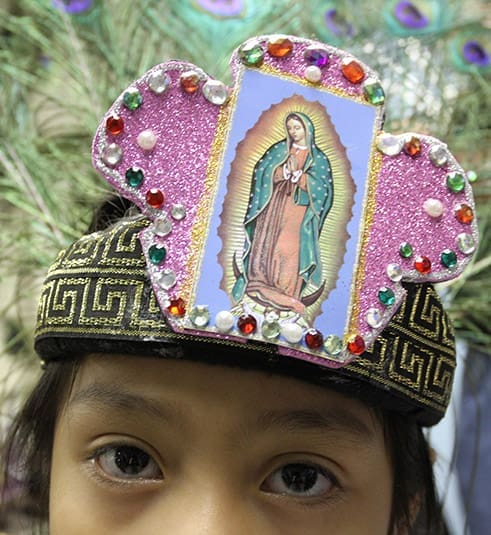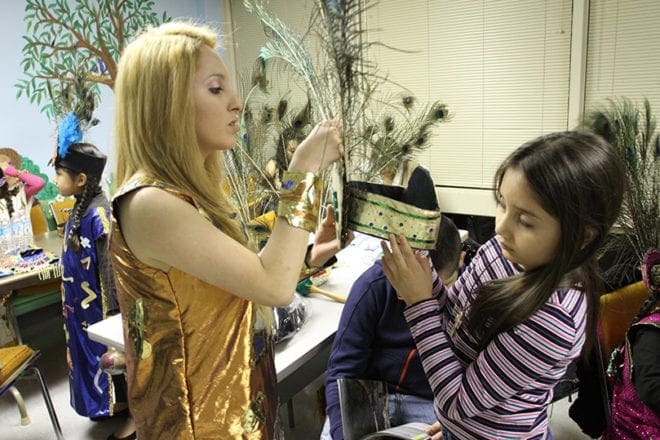 Photo By Michael Alexander
Photo By Michael AlexanderSnellville
Guadalupe Devotion Passes On To New Generation
By STEPHEN O'KANE, Staff Writer | Published December 20, 2012
Donning ornate headdresses with colorful peacock feathers and handmade costumes featuring an Aztec-inspired design, 40 dancers processed into the sanctuary at St. Oliver Plunkett Church at the end of a Mass honoring the feast day of Our Lady of Guadalupe.
Lorenzo Hernandez, 48, a parishioner, led the group of dancers as he has for the past several years. Growing up in Durango, Mexico, the feast of Our Lady of Guadalupe was an important expression of faith for Hernandez and his family. So important that he has made an effort to pass along the celebration of the feast to his own daughters, Miriam, 23, and Jade, 6.
Both girls danced with Hernandez at the Mass on Dec. 12, along with his wife, Rebecca. The dancing has become an annual tradition for the young family and one that they look forward to every December.
“Dancing is an expression of our faith,” said Hernandez.
His daughter Miriam began the tradition about six years ago, when she first joined the group of dancers. She had seen and heard about it from her parents and was excited when she was able to join as a dancer.

Five-year-old Emily Sanchez waits as the other dancers around her get ready for their performance on the feast of Our Lady of Guadalupe, Dec. 12. The age range of the dancers goes from five-years-old up to 48. Photo By Michael Alexander
“My parents would tell me about it,” said Miriam. “Every state has its own cultural dance, but this one is pretty much done all over Mexico. … I love the colors, the symbols.”
At the end of the Mass, the dancers gathered in the narthex, lined up and ready for their procession into the church. A strong drumbeat began as the dancers matched the rhythm with gourd rattles moving in unison as they filed into the aisles and the space in front of the altar. One dancer led the procession waving a large replica of the image of the Virgin of Guadalupe.
As they found their place they began moving to the music, spinning, jumping and shaking their limbs to the beat. The assembly watched intently, cheering and applauding at the end of each portion of the dance. Following their performance, the dancers processed out in much the same way they entered, only this time panting and sweating after an intense display of tradition.
“We do not celebrate just today,” said Hernandez. “We celebrate every single day.”
Miriam added that many Mexican families keep a picture or statue of the Virgin of Guadalupe in their houses so they can honor her all year long. Many families pray the rosary together before their home altars or shrines, keeping the story of Guadalupe fresh in their daily prayers and devotions.
The passing along of Guadalupe traditions can be seen in the dance group itself, as several generations are represented. Hernandez, his wife, his two daughters and other extended family members all danced together at St. Oliver. A large portion of the dancers this year were under the age of 10, said Miriam.
The group practices one day a week for about three months leading up to the feast day celebration, giving the dancers and their families a concrete way of honoring Our Lady of Guadalupe. For Jade, Hernandez’s youngest daughter, her favorite part is “being with family.”
Honoring the cultural heritage of St. Juan Diego, the central figure in the story of Our Lady of Guadalupe, the performance features Aztec-themed costumes and uses dance as a form of prayer to recognize the centuries of tradition that followed the momentous events of the saint’s life.
According to an article on the Marian Library website of the University of Dayton, tradition teaches that on Saturday, Dec. 9, 1531, the Virgin Mary appeared to Juan Diego, an Indian and newly Christian convert, on the hill of Tepeyac, near present-day Mexico City, where the Indians venerated the goddess Tonantzin. Mary spoke the indigenous Nahatl language and she sent Juan Diego to ask the bishop of Mexico to erect a sanctuary at the foot of this hill.
He went to Topetlac, the colonial city where the bishop and the government of the Conquistadores were located. Juan de Zumarraga, the founder of the diocese, a Franciscan, avoided the request of Diego, whom even the servants apparently disdained.
However, after the fourth apparition, on Dec. 12, the Virgin gave signs to confirm its authenticity. She sent Juan Diego to carry to the bishop a miraculous bouquet of flowers blooming on the barren site of Tepeyac. He carried them in his tilma, a mantle he wore that was woven from the fibers of maguey, and placed them before the prelate. At this point, according to the tradition, in the interior of the mantle the life-size image of the Virgin miraculously appeared, the same one that is venerated today. Her image, which is rich in detail and theological import, shows Our Lady as an olive-skinned woman with dark hair. A black band at her waist reflects the traditional dress of a woman in pregnancy.

Seventeen-year-old dancer Mayra Martinez puts peacock feathers in her penacho as she gets some assistance from her seven-year-old cousin Kayleen Zapata. Photo By Michael Alexander
Following the apparition, enormous conversions to Christianity took place among the indigenous people.
Guadalupe was the first apparition of modern times, which led to the foundation of a sanctuary of permanent influence, national and worldwide, in the Basilica of Guadalupe, a place that Mexicans consider to be the greatest destination of pilgrimage in the world after Rome. The Basilica of Guadalupe sees some 7 million pilgrims each year, the most visited Catholic shrine in the world.
The present-day church was built on the site of an earlier 16th-century church that was finished in 1709. When this basilica became dangerous due to the deterioration of its foundations, a modern structure was built next to it.
The original image of the Virgin of Guadalupe is now housed in this new basilica. Its colors have not faded and the tilma has not deteriorated.
Built between 1974 and 1976, the basilica has a circular layout so that the image of the Virgin can be seen from any point within the building. The structure can accommodate up to 50,000 people. It has nine chapels on the upper floor. Under the main floor are the basilica’s crypts, with some 15,000 niches and 10 chapels.
The St. Oliver Plunkett Church group of dancers was just one facet of the multiday celebration. Elaborate processions, lively music and traditional food were also included in the commemoration of the feast.
But Our Lady of Guadalupe is not only a profound celebration for those of Mexican heritage as the story and traditions continue to be recognized by those of varying backgrounds and cultures. In 1999 Our Lady of Guadalupe was declared by Pope John Paul II as patroness not just of Mexico, but of all the Americas.
Patroness Of The Americas
- Our Lady of Guadalupe is the title given to the Virgin Mary after appearing, according to tradition, to St. Juan Diego, an Aztec convert to Catholicism, in the village of Guadalupe near present-day Mexico City in 1531.
- Two basilicas bear the name of Our Lady of Guadalupe: the first, begun in 1531, and the current one, built between 1974 and 1976 by the Mexican architect Pedro Ramírez Vásquez.
- Directed by the Virgin’s request, Juan Diego carried flowers in his cloak to the local bishop to show the authenticity of the apparitions. When flowers fell from the mantle, a life-size image of Our Lady of Guadalupe was imprinted there miraculously. The same mantle containing her image is displayed today, over four centuries later, in the Basilica of Guadalupe in Mexico City. The image is of a woman with olive skin, rather than the white skin of European iconography, that appealed to both indigenous Mexicans and their mestizo descendants as one of them. Similarly, Juan Diego was an Indian, not a European Spaniard. She is depicted as pregnant, shown by the black tie at her waist.
- The apparition immediately led to enormous numbers of conversions to Christianity by the indigenous people of the region.
- Advocates of indigenous rights throughout Mexico’s history have drawn inspiration from the image of Our Lady of Guadalupe.
- Replicas can be found in thousands of churches throughout the world, including Notre Dame Cathedral in Paris, France. Numerous Catholic parishes also bear her name.
- She was declared the patroness of all the Americas by Pope John Paul II in 1999.